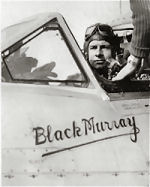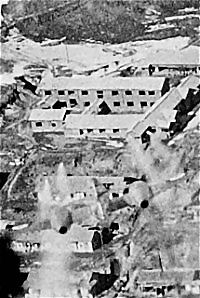MEMORIES OF KOREA
| Service details Kenneth Murray was one of the three early pilots to serve in Korea( after World War 2 experience) and flew the greatest number of missions (333) of all theUnited Nations pilots in Korea. He was later the Chief Test Pilot for the RAAF beforebeing medically retired after a distinguished and gallant service history. In 1950 I was posted to 77 Sqn Kimpo, Korea, after a three monthOperational training course at Williamtown, NSW, on Mustangs and Vampires. |  Sgt (Later F/O) Phillip Zupp, in Meteor "Black Murray." |
Kimpo was a US Air Force Base with all facilities presumably providedby them. We lived four to five in a tent with a wooden floor and central heating wasprovided by a pot bellied stove. This must have been reasonably effective because the onlytime I remember the bone-numbing cold was sitting for an hour or so in an unheatedaircraft when on stand-by for action. The pot-bellied stove was in operation day and nightand when someone absent-mindedly left a can of baked beans on top, caused it to explodewith a loud roar. The occupants all dived further under the blanket to avoid a cascade ofhot beans but nevertheless they completely impregnated the inside of the tent which had tobe replaced. A more successful cooking venture was a succulent stew whipped up by one ofour operation officers, who considered himself quite the hunter and bagged what he couldhit in the way of birds.
The airfield was constructed of sheets of metal mesh (PSP - piercedsteel plate) and apart from one Navy pilot who touched down and pulled up the metal sheetsof the runway behind him in curls like the lid of a sardine can, it served its purposevery well.
Pilots were briefed the night before on what missions were to be flownnext day. These usually involved about sixteen aircraft (Meteor 8s) which took off infinger four formation. This allowed the wing men to cover the leader and each other in theevent of an enemy aircraft attack. Take off time could be anywhere between first light andlast light.
On my first tour of duty I was engaged in fighter sweeps patrollingnorth to the Yalu river. We also provided fighter cover for bombing raids initially by USB29s then B26s.
Our main protagonists were MIG 15s flown by Russians - skilled pilotsin a superior aircraft. We could only hope for quick delivery of Sabre jets, which theAmericans were already flying, in order to even up the odds.
We were involved in many dog fights, begun by whoever had the greatestadvantage and though we shot down a few MIGs they got more of ours.
Strict radio silence was imposed but not always observed. One excitedoutburst from an American pilot who was hit drew the laconic comment in a plummy OxfordEnglish accent, "Oh, shut up and die like a gentleman!". Fortunately itdidn't come to that and the American returned safely to base. The plummy accentbelonged to one of the RAF pilots seconded to 77 Sqn and as we all dined with theAmericans in the Officers mess relations were really quite cordial. The food was excellentand with the help of the nurses they hosted some great parties.
The RAAF ground crews did a wonderful job under difficult conditionsreadying aircraft for operations. As there were no hangars, the aircraft were parked onthe flight lines at the mercy of the elements and often had to be swept clean of snowbefore any work at all could begin. I don't recall too many missions aborted due toweather conditions but obviously there would have been some.
Every six weeks 77 Sqn pilots would fly their aircraft to Iwakuni forservicing and bring back new ones. This two day break gave us a chance to catch up withfriends and visit the town of Iwakuni. The Mess had been the setting some time before fora rather famous incident involving General Robertson ("Red Robbie") and a 77 Sqnpilot. The boys were letting their hair down one evening playing "Fighters andBombers" and pilot "X" was perched in the rafters of the hut waiting todive bomb the next person through the door. To say that the General was annoyed at beingfelled by the not insubstantial body of pilot "X" would be the understatement ofthe year. The festivities came to an abrupt halt. Pilot "X" was banished,paraded before the CO next day and promptly demoted.
Laundry was done on an "ad hoc" basis being sent to Iwakuniin a kit bag and processed by your designated Japanese room girl for a small fee. Thegirls were honest, efficient and obliging but to our dismay seemed to consider darningsocks to be a work of art and so decorated our black woollen service socks with repairs inred, blue or whatever colour wool came to hand! The technicolour monstrosities lastedforever and caused a great deal of comment on our return to Australia.
After 195 missions in my first tour of duty I was "medivaced"out of Korea with glandular fever and spent a month in hospital at Iwakuni. On release Iwas given two months recuperation leave in Australia.
When I returned to Korea for the second time the operational tasks weremainly rocket strikes and we found that the MIGs were being flown by Chinese pilots ratherthan Russian as evidenced by their radio conversations. They were not as skilled as theRussians which gave us some advantage. The Chinese forces on the ground used to movearound at night and take shelter by day in the local villages, so they were ratherdifficult to find. It did not deter them however from shooting at us with rifles when wedived down to take a closer look and occasionally they got lucky.
Editor's note
During his second tour of duty "Black" Murray wascommissioned and became a Pilot Officer. He had been awarded a Distinguished Flying Medal(DFM) and American Air Medal as a flight sergeant and later was awarded a DistinguishedFlying Cross (DFC) as a Pilot Officer..
Whilst the American pilots flew 100 Combat missions before going home,Wal Rivers and I managed to clock up 319 and 333 respectively.
Whilst I was in Korea, 77 Sqn lost 45 pilots, including some who weretaken prisoner and later released, and even more aircraft. The pilots included many youngmen from the RAAF Academy at Point Cook and who, in hindsight, were insufficiently trainedin combat. They also included many good and valued personal friends.
Korea is probably the last theatre of war where the type of air to aircombat we experienced would occur.
The Korean War has always been considered by some as a mere policeaction under the auspices of the United Nations and downgraded as a result. For all thoseinvolved, it was a matter of fulfilling Australia's commitment to the UN and theyresponded with alacrity , courage and honour to its demands.
I personally think that the outcome was successful in that it stoppedthe Communist advance south for some 40 or so years. Whether in the light of recent eventsit was worth the cost in human lives, remains for posterity to judge.
********************
|
|
